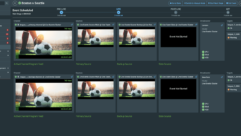Meeting expectations
Nov 1, 1999 12:00 PM,
Steve Binder
For 10 years, the Paradise Performing Arts Center awaited a soundreinforcement system whose sophistication could be supported only bytoday’s technology.
Systems contractors are often called upon to wear a diverse group of hats.Certainly, there is the issue of being a systems expert, which requiresfluency in effectively implementing the latest technology, more and more ofit digitally based. Another discipline often required is that ofacoustician.
More often than not, systems projects demand a good understanding ofstructural engineering. Certain projects may require even more knowledge ofspecialized disciplines. Also, a systems integrator must definitely take onthe role of diplomat, countering the lack of understanding or flat-outcarelessness exhibited by architects, general contractors, constructioncrews and the like.
Joe Orlando of Commercial Sound & Communications, based in the SanFrancisco Bay Area, recently had the opportunity to model several hatswhile implementing a new sound reinforcement system at the ParadisePerforming Arts Center, Paradise, CA. The privately owned facility has beenopen for about 10 years, but during that time, it operated without a soundsystem until funding became available. In the interim, rental systems werebrought in to support a wide range of acts, including country and rockperformances as well as ballet and theatrical productions.
A sound system design had been formulated when the facility was beingbuilt, a process handled by Paoletti and Associates, San Francisco.Commerical Sound & Communications, along with several other firms, suppliedproposals based on that original design, even though it was almost a decadeafter the fact.
“We suggested from the outset that the design needed to be modified toreflect numerous technology advancements since that time,” Orlando said.”The Paoletti design was quite good, but certainly it needed to be updated.For example, we could provide a bit more cost effectiveness, as well asincreased functionality, through use of digital devices that would replaceracks of analog equipment and patch panels in the original spec.”
Coverage criteria
The auditorium of the Paradise Performing Arts Center offers intimacy withthe performers who grace its stage. More than 750 seats are split into amain center section flanked by two smaller side sections, all of which fanout slightly from the orchestra pit to the back of the room, with the floorgently elevating. There are no balcony or luxury boxes.
Acoustically, the room is “pretty live,” according to Orlando, “but this isthe way ownership wants it. The architect had specified a series of wooddeflector panels to cover much of the ceiling, to keep energy focused onthe audience area.” Using this plan, Commercial Sound installed a total of57 panels, each with 540 infinity 540 (348 cm infinity 348 cm) ofreflective surface, quite an intensive process from labor and logisticalstandpoints.
The original sound system design had called for a central loudspeakercluster – to be flown above the orchestra pit – for coverage to most of thehouse. This would be supplemented by a delay cluster positioned about 75feet (23 m) from the main cluster. Orlando saw no reason to deviate fromthis idea, and he began a search for loudspeakers that would appropriatelyfit the criteria, including a look at the recent AS series from EasternAcoustic Works (EAW), demonstrated at the NSCA show by John Frigaard ofj.n.d., Fairfax, CA.
Orlando surmised that three EAW ASR660 three-way loudspeakers, offering a60degree infinity 45degree mid- and high-frequency coverage pattern, wouldperfectly fit the coverage criteria defined by the design, which was basedon extensive room modeling. Housed in a compact horizontally orientedenclosure only 22 inches (559 mm) tall, the ASR660s would also fitunobtrusively within the elaborate acoustical panel mosaic at the ceilingwhile offering good vocal intelligibility via a dedicated horn-loadedmid-range section along with dynamic full-bandwidth performance for music.
“The ASR660s provide extremely tight pattern control, helping us keepenergy squarely on the audience and off reflective wall surfaces,” Orlandosaid. “The Tuned Dipolar Array concept employed in the low-frequencysection of these loudspeakers were also crucial to the success of theproject. The position of the cluster, which couldn’t be altered, presentedthe potential for excess low-end energy to wreak havoc with mics on stageand in the pit. We needed the extra control, and we got it. The results,which in a nutshell is completely predictable output, have been impressive.”
A single ASR660 is assigned to cover each seating section, with all threeloudspeakers tightly packed and a 50degree splay angle between thecabinets. This optimum splay angle, as well as the exact downfiring angleof each loudspeaker, were finalized after consultation with the EAWengineering department. This process was also aided by a new flyinghardware system, offering extreme precision, just introduced by Polar Focusof Hadley, MA (more on this later).
The three main loudspeakers provide smooth, seamless coverage out to about80 feet (24.4 m), where the output of a compact loudspeaker cluster, ontime delay, is feathered in to extend the system’s reach to the backseating row. This compact cluster consists of a single EAW AS422low-frequency loudspeaker, which is loaded with dual 12 inch (305 mm)woofers and features Tuned Dipolar Array control, flanked by two EAW AS490mid/high-frequency loudspeakers. As with the main loudspeakers, these unitsare only 22 inches (559 mm) high, again making them quite unobtrusivewithin the aesthetics of the room.
“We just needed some fill energy toward the back of the room, an extra pushbut nothing huge,” Orlando said. “There also wasn’t need for a lot oflow-frequency energy, and again, control was paramount.”
All loudspeakers are driven by AB International model 1590B power amps,mounted in a Middle Atlantic rack positioned at the sound booth, located atthe rear of the room. The ASR660s are biamplified, with each low-frequencysubsection on its own channel and the mid/high sections sharing channels.”The AB amps really help balance the budget versus quality equation,”Orlando said.”They’re solid, with a nice sound. You can really beat them upand they don’t care.”
New rigging
As mentioned, the Paradise Performing Arts Center project featuresdeployment of a recently introduced flying hardware system, a facet uponwhich Orlando is more than willing to expound. The issue of loudspeakerlocation, already difficult enough given the extensive ceiling panelsystem, was further complicated by a lack of cooperation by other vendors.
“I guess it’s probably no surprise when I say that many of the contractorson the project didn’t understand or didn’t care to understand the scope ofwhat we were doing with the sound system,” Orlando said. “Other trades ingeneral aren’t sensitive to what needs to happen with a system. Forexample, the electrical contractor just located his conduit whereconvenient, without regard to the general building plans or our specific,stated needs. They even tried to move some of our rigging without tellingus and certainly without any regard or thought as to the impact it mighthave.”
Even prior to the project, Orlando had been evaluating the new riggingsystem from Polar Focus, called ZBeam, finding it intriguing and perhapsoffering a new solution to a very old and often frustrating problem. Ratedfor 880 pound (396 kg) loads with a 10:1 design factor, ZBeam can bedescribed as a stock universal audio “bumper” that will suspend virtuallyany loudspeaker equipped with safe rigging points in a seemingly infinitenumber of configurations. In effect, it acts as a custom rigging system,but in stock form, that can be tailored to specific needs.
ZBeam is designed for fast and effective rotational control around avertical z axis for balanced loads. Azimuth angle is held by a largefriction bearing, set with four vernier scales. Standard, approved aircraftcable or wire rope lets the rigger set and control elevation angles.
“Basically, it’s a bar on top of a bar with a joint in the center thatswivels in and out,” Orlando said. “With this pivoting action, you canessentially place and aim a loudspeaker anywhere you want, and at any angleyou want, flown from just two pieces of wire rope, and if you know theproper technique, you can float the ZBeam just about anywhere in thebuilding using just three rigging points.
“If you use a snatch-block technique on the lower bar, in essence av-shaped wire rope with a snatch block attached to the back flypoint on theloudspeaker, you can tip it to any angle you want, and then use the pivotto point it in any direction. A graded scale on the bar tells you exactlyhow many degrees you’re pivoting the box.”
This highly flexible scheme allowed the loudspeakers in both the main anddelay clusters to be flown at the optimum positions despite theinfrastructure difficulties presented by other contractors as well as theceiling panels. Polar Focus also visited the job site during the project tooffer first-hand guidance.
Digital flexibility
Orlando selected a BSS Soundweb model 9088 as the house sound system signalprocessor, providing even more capability than racks of outboard processinggear specified in the original design. This digital unit saved quite a bitof space in the sound booth, lowered costs dramatically, and it allowed theloudspeakers to be tuned and tailored to an optimum degree.
For example, each frequency band has its own four-band parametric EQ withlimiters and compressors on each output. All of these parameters arepassword protected and therefore cannot be altered by unauthorizedpersonnel. Guest engineers, however, have the option of patching in up tofour AB International graphic EQs to tailor the system’s signature.
A Spirit 8 32-channel console resides at the front of the sound booth,selected for its sound quality and ease of use. It can be called upon to dodouble duty as a monitor console for smaller productions, and the ABInternational graphic EQ’s can be inserted for this purpose as well.Monitoring in the enclosed booth is done via two EAW UB12 compactloudspeakers, time delayed with Soundweb to be in sync with the housesystem.
“Soundweb is probably the finest signal processor on the market right now,”Orlando said, adding that it offered other capabilities well suited to thisproject.
The unit’s matrix router is interfaced with an AMX Accent II mainframethat, in turn, supports two AMX touchpanels, one located in the booth andthe other backstage. As a result, the sound operator or stage manager canroute house audio programming to a number of peripheral sound systemslocated in dressing rooms, the lobby, restrooms and other common areas.
The AMX devices were programmed by Jeff Galatro of Commercial Sound &Video, Antelope, CA, which enjoys a good working relationship with Orlando.In fact, they also handled the documentation and CAD drawings for thisphase of the project.
All of these remote systems are driven by a pair of Biamp Systems CMA120mixer/amplifiers, which feed Quam Nichols model 8C10FECO coaxial ceilingloudspeakers. When in use, they also are time delayed in relation to thehouse system, again courtesy of Soundweb. A TOA model MP-032B monitor panelresiding in the booth has been inserted to allow the sound operator tomonitor the peripheral systems at any time.
Finally, a Biamp Systems DLA93 digital programmable automatic mixer is alsoaccessible via the AMX touch-panels. When selected, the mixer routes avariety of mics as well as CD and cassette players through the house andperipheral systems. It is an ideal setup for situations not demanding majorproduction elements, capable of being operated by laymen. All of theseelements are positioned in the sound booth.
The stage floor includes plenty of input/output pockets, and both stageleft and right offer 32-channel input panels that link back tocorresponding 32-channel ADC patchbays in the sound booth. These panelsalso include four intercom channels, for the house-wide Telex intercomsystem, along with two paging mic inputs and four stage monitor outputs.
Even more intercom system patch points are located at the loudspeakerrigging positions and in the catwalks along the ceiling. Several monitoroutputs were routed to this region as well to accommodate effectsloudspeakers when needed. The miles of cabling to accomplish all of thiswas supplied primarily by West Penn, while Horizon loudspeaker and snakecables were the choice with the house system.
“This was our first time out with Horizon product on a job of this scope,and we were really pleased,” Orlando said. “It was well labeled, cleanlylaid out and easy to use.”
Other accoutrements include a Telex model Sound Mate RF-based assistedlistening system as well as several Audio-Technica ATM41HE mics and a pairof Audio-Technica 7000 series UHF wireless mic systems with antennaspositioned above the sound booth for optimized reception.
Multiple disciplines
“As I look back at this project, the things that stand out most are theloudspeaker rigging and the digital processing,” said Orlando. “They serveas prime indicators of the advancements being made in systems technology,particularly when you contrast it with 10 years ago, the time of theoriginal design. Another good example is that the specification called forthe main system to provide low-frequency performance down to 80 Hz. Thecombination of the AS series loudspeakers and Soundweb digital technologytakes us way below that figure, to the point where subwoofers are reallyunnecessary in this facility.”
Notable too are the diverse specialties demanded of today’s systemscontractor. This project involved a wide range of elements; Orlando wasrequired to juggle them all competently to achieve the desired results.
“We envisioned a good, solid sound reinforcement system that would functionfor years to come while fully taking advantage of new technology to equate,and likely surpass, the performance expected of the original design,” hesaid. “On the surface, you wouldn’t think this would be all that tough todo. But we’ve gone past the point where we simply install speakers and ampsand then hand over the keys to the owner. Systems contracting, now morethan ever before, is a multidiscipline profession.”










